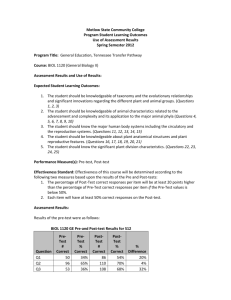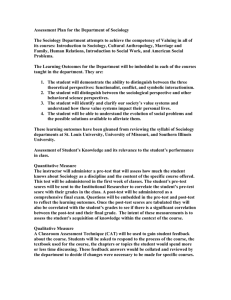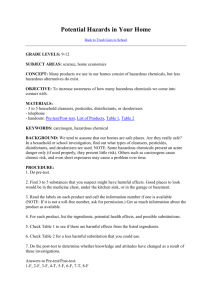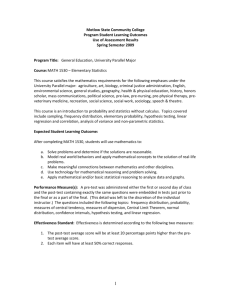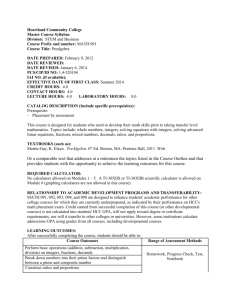General Inorganic Chemistry Laboratory II
advertisement
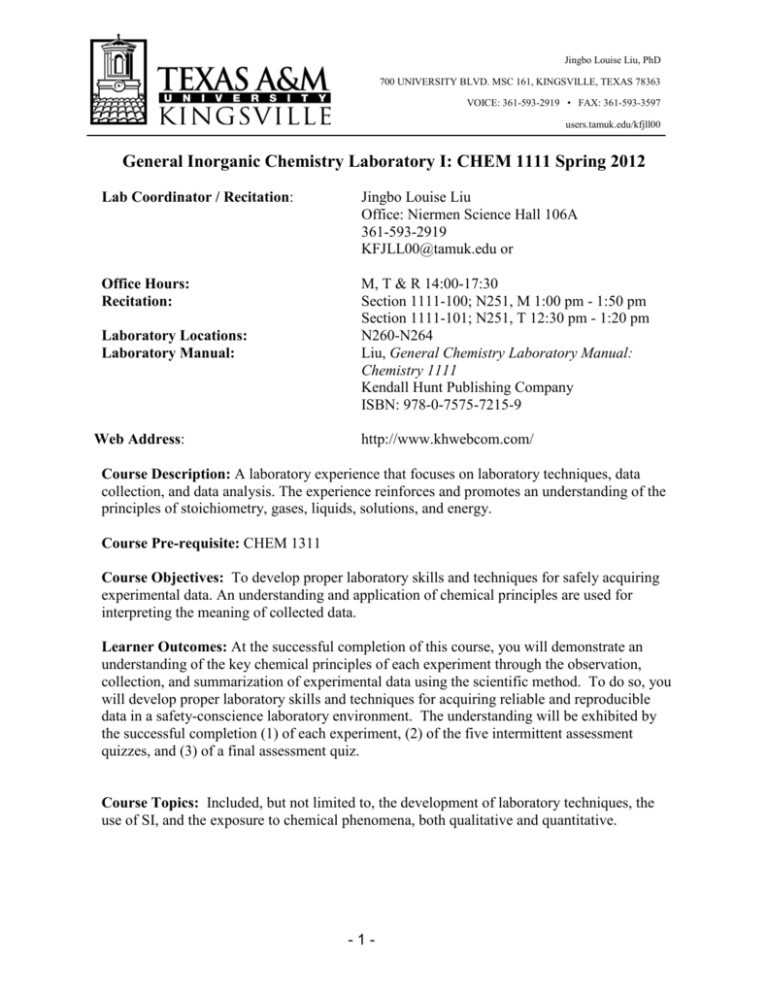
Jingbo Louise Liu, PhD 700 UNIVERSITY BLVD. MSC 161, KINGSVILLE, TEXAS 78363 VOICE: 361-593-2919 • FAX: 361-593-3597 users.tamuk.edu/kfjll00 General Inorganic Chemistry Laboratory I: CHEM 1111 Spring 2012 Lab Coordinator / Recitation: Jingbo Louise Liu Office: Niermen Science Hall 106A 361-593-2919 KFJLL00@tamuk.edu or Office Hours: Recitation: M, T & R 14:00-17:30 Section 1111-100; N251, M 1:00 pm - 1:50 pm Section 1111-101; N251, T 12:30 pm - 1:20 pm N260-N264 Liu, General Chemistry Laboratory Manual: Chemistry 1111 Kendall Hunt Publishing Company ISBN: 978-0-7575-7215-9 Laboratory Locations: Laboratory Manual: Web Address: http://www.khwebcom.com/ Course Description: A laboratory experience that focuses on laboratory techniques, data collection, and data analysis. The experience reinforces and promotes an understanding of the principles of stoichiometry, gases, liquids, solutions, and energy. Course Pre-requisite: CHEM 1311 Course Objectives: To develop proper laboratory skills and techniques for safely acquiring experimental data. An understanding and application of chemical principles are used for interpreting the meaning of collected data. Learner Outcomes: At the successful completion of this course, you will demonstrate an understanding of the key chemical principles of each experiment through the observation, collection, and summarization of experimental data using the scientific method. To do so, you will develop proper laboratory skills and techniques for acquiring reliable and reproducible data in a safety-conscience laboratory environment. The understanding will be exhibited by the successful completion (1) of each experiment, (2) of the five intermittent assessment quizzes, and (3) of a final assessment quiz. Course Topics: Included, but not limited to, the development of laboratory techniques, the use of SI, and the exposure to chemical phenomena, both qualitative and quantitative. -1- This Chemistry 1111 Syllabus is intended to be informational. The instructor reserves the right to amend or modify the syllabus in any manner that she deems necessary and in the best interest of Texas A&M University-Kingsville. Rec Dates/ Mon/Tue Jan 23-24, 2012 Jan 30-31, 2012 Feb 06-07, 2012 Feb 13-14, 2012 Feb 20-21, 2012 Feb 20-21, 2012 Feb 27-28, 2012 Mar 05-06, 2012 Mar 12-18 Mar 19-20, 2012 Mar 26-27, 2012 Apr 02-03, 2012 Apr 09-10, 2012 Apr 16-17, 2012 Table 1. Spring 2012 CHEM 1111-100/101 Recitation Schedule Expt. Content 0 Review Syllabus (Do in Recitation), Laboratory Safety (Do on-line), and Check-in (Do in-Lab) 1 Introduction to Nanoscale Science (Dry lab, No need to come to the laboratories) Pre-Test MUST be COMPLETED BEFORE LAB Post-Test is COMPLETED AFTER LAB 2 Flame test and density determination Pre-Test MUST be COMPLETED BEFORE LAB Post-Test is COMPLETED AFTER LAB 3 Physical and chemical properties of materials Pre-Test MUST be COMPLETED BEFORE LAB Post-Test is COMPLETED AFTER LAB 4 Heat transfer Pre-Test MUST be COMPLETED BEFORE LAB Post-Test is COMPLETED AFTER LAB 5 Vinegar analysis and limiting reactants determination Pre-Test MUST be COMPLETED BEFORE LAB Post-Test is COMPLETED AFTER LAB 6 Precipitation reaction Pre-Test MUST be COMPLETED BEFORE LAB Post-Test is COMPLETED AFTER LAB 7 Redox reaction Pre-Test MUST be COMPLETED BEFORE LAB Post-Test is COMPLETED AFTER LAB No labs Spring break 8 Ideal gas collection Pre-Test MUST be COMPLETED BEFORE LAB Post-Test is COMPLETED AFTER LAB 9 Molecular structure Pre-Test MUST be COMPLETED BEFORE LAB Post-Test is COMPLETED AFTER LAB 10 Nano-silver noble metal fabrication Pre-Test MUST be COMPLETED BEFORE LAB Post-Test is COMPLETED AFTER LAB 11 Miniature Hydrogen Vehicle (Make up) Pre-Test MUST be COMPLETED BEFORE LAB Post-Test is COMPLETED AFTER LAB Check-Out (during your regular lab day) -2- • • • • • Each LAB is a total of 100 points (see marking scheme). The breakdown is as follows: The pre-lab part is 20 points and must be turned in to your TA at the beginning of the related labs, lab technician or lab instructor must sign students’ papers. The post-lab part is 20 points and must be turned in to your TA at the beginning of the flowing lab assignments, lab technician or lab instructor must sign students’ papers. Lab report is 60 points and must be turned in to your TA during the related labs, lab technician or lab instructor must sign students’ papers. No LATE lab report is accepted by all means. Note: • The students are required to remain in the related lab until they have completed all calculations and submit the report sheet before leaving. • At the beginning of labs, students must turn in the Pre-lab for that day’s experiment and the Post-lab for the previous experiment. • Students must complete the blackboard lab safety training if they have not previously done so. If students already completed lab safety training last semester (Fall 2011) for any class Biology, Chemistry, Engineering, etc., they do not have to repeat the training this semester (Spring 2012). 1) 2) 3) 4) 5) Rules and Requests Attendance to all class recitation is not only mandatory, but also an obligation for a comprehensive understanding of the chemical principles of Chemistry CHEM 1111 (NOTE: All students must attend the recitation; otherwise, students will NOT be allowed to enter the laboratory). Appropriate safety attire and appearance are required in the laboratory, including eyewear, clothing, and shoes. Arms, legs, and feet will be covered! If you miss your lab session, check with the Technical Coordinator for the option of making up the lab with another section the same week. One laboratory makeup session is offered at the end of the semester. The Pre-Test Assignment is due before the beginning of the laboratory session. The Post-Test Assignment is due before the beginning of the next laboratory session The Lab Report Data Analysis section for the experiment is to be completed during lab and at the end of the lab session, the Teaching Assistant (TA) signs your Data Analysis section to prove that you did the lab. The Lab report section is completed and given in at the start of the next lab The use of tobacco, food, drink, and/or gum is prohibited in the laboratory. Cell phones are to be turned off during Recitation. Laboratory Information The Laboratory Team: • Teams of 2 students will combine their talents in the laboratory. Teams may be selected by the Teaching Assistant (TA). • Each member of the team will submit separately the Pre-Test Assignment for each experiment. • Each member of the team will submit separately the Post-Test Assignment for each experiment. -3- • • • Each team member will submit a separate Data Analysis section and Lab Report at the beginning of the next lab (e.g. hand in report for Experiment 1 at the beginning of Experiment 2 and so forth) The pre-test, post-test are completed and turn in to your TA when enter the lab. The lab report is also submitted on-line except the data analysis section which is completed during the lab. Print out the experimental procedure section and bring it to the lab. This will explain how to carry out the experiment. Also print out the data analysis section, which is completed as you carry-out the lab. Team discussions are an integral part to understanding the experiment; you are expected to discuss the techniques and procedures for collecting the data and the method(s) used for their analysis. The intent of teaming is not to establish a division of labor in the laboratory, but rather to use the collective talents of the team members for a more thorough understanding and completion of the experiment. The Laboratory Assistant will provide guidance to team participation as needed/requested. If a member is not contributing to the team effort, that person may be moved to another group or required to work on their own. Team Member Absences: If a team member is absent or fails to submit a Pre-Test Assignment or Lab Report, a grade of zero will be recorded for the corresponding part for that student (not the team). The remaining team members will be scored as if the entire team were present. Grossly deficient Pre-Test Assignments or Lab Report may be assessed an individualized penalty at the discretion of the Lab Assistant. If team participation falls to less than 2 for two consecutive laboratory sessions, teams may be changed by the Lab Assistant. The format of the Lab Report should include: I. Cover page- experiment number and title, date of experiment, chemist, and chemist’s team number, names of team partners) II. Objective (one or two sentences) III. Theory (100-200 words – use your own explanation of the theory of the experiment, general ideas, principles, concepts. Ideas from the Introduction section of the lab manual may be used. Include main equations, chemical formulas.) IV. Procedure (200 words: general description of the procedure as it was performed) V. Report sheet (From the lab manual, neatly written in pencil, to be completed before leaving the laboratory. Graphs may be done neatly by hand or by computer) VI. Results and discussion (200 words approximately – What are the main results of the experiment? What conclusions can be derived from the results? How good is the accuracy of your results? What systematic and random errors affected your results? Include some values and formulas when describing results and accuracy.) VII. References Journals: Author, Journal, Vol, page (Such as : E. D. Wachsman, Solid State Ionics, 152-153, 2002, 657-662) Book: Author, Pulishers, title of the book, press, location, year, page (Such as : Vitalij K. Pecharsky and Peter Y. Zavalij, Fundamentals of Powder Diffraction and Structural Characterization of Materials, Kluwer Academic Publishers, Norwell, MA, -4- 2003, PP29-58. ) VIII. Name of your lab partner -5- Grading Policy Lab Grades: The experimental score (70 % of total score) is based upon the grades of the Laboratory Reports. 30 % is based on the pre-lab. The grading of each team's Laboratory Report is distributed according to: Marking Scheme (100 pts in total) Content Pre-test Lab report Points for each question Objectives: Introduction Procedure Data and observation Conclusion Acknowledgement References Post test 5 5 10 25 Total Points 20 60 5 5 5 20 Calculating your final grade: Letter grade A B C D F Q points percentage >900 90% 800 - 899 80-89.9% 700 - 799 70-79.9% 600 - 699 60-69.9% < 599 < 60% Withdraw the course (see University Calendar) 10 Labs= 10 × 100= 1000 points in total -6- University Policies Dropping the course: Follow the university calendar. Students with Disabilities: Through SSD, TAMUK assists in academic adjustment and provides auxiliary aids to students with disabling conditions, as defined under law, who are other wise qualified to meet the institutions academic requirements. To receive services that fall under the Americans with Disabilities Act, disabled students must register with the Office of Services for Students with Disabilities (SSD) (593-3024). Students with disabilities, including learning disabilities, who wish to request accommodations in this class, should notify the SSD Office early in the semester so that appropriate arrangements can be made. Prohibited Conduct: Examples of behavior for students who are subject to disciplinary action are defined in the Student Handbook. For additional information, consult the Student Handbook, the University Catalog, the Student Organization Handbook, the Residence Hall Agreement, the Student Family Apartment Agreement, and/or the Residence Life Guidebook. Drop Policy: Senate Bill 1231, passed by the Texas legislature in 2007, limits the number of drops (six) that undergraduate students may accrue without a punitive grade. Undergraduates completing a high school program and enrolling in an institution of higher education prior to fall 2007 are exempt. Undergraduate students completing a high school program and enrolling in an institution of higher education for the first time on or after the fall semester 2007 are subject to the law. (See Catalog, pp. 57+). Important Dates First Class Date (For University on Wed/Jan/18/2012) 12th Class Date. No registration after this point Five week Date Spring Break Last day to drop the course with an “automatic “Q” Date Good Friday Holiday The last day to drop the course or withdraw from the university Last Class Date (For University on Thu/May/03/2012) -7- Wed/Jan/18/2012 (for CHEM 1312) Thu/Feb/02/2012 Wed/Feb/22/2012 Mon/Mar/12/2012 → Sun/Mar/18/2012 Thu/Mar/22/2012 Fri/Apr/06/2012 Thu/May/03/2012 by 5:00 pm Wed/May/02/2012 (for CHEM 1312)


